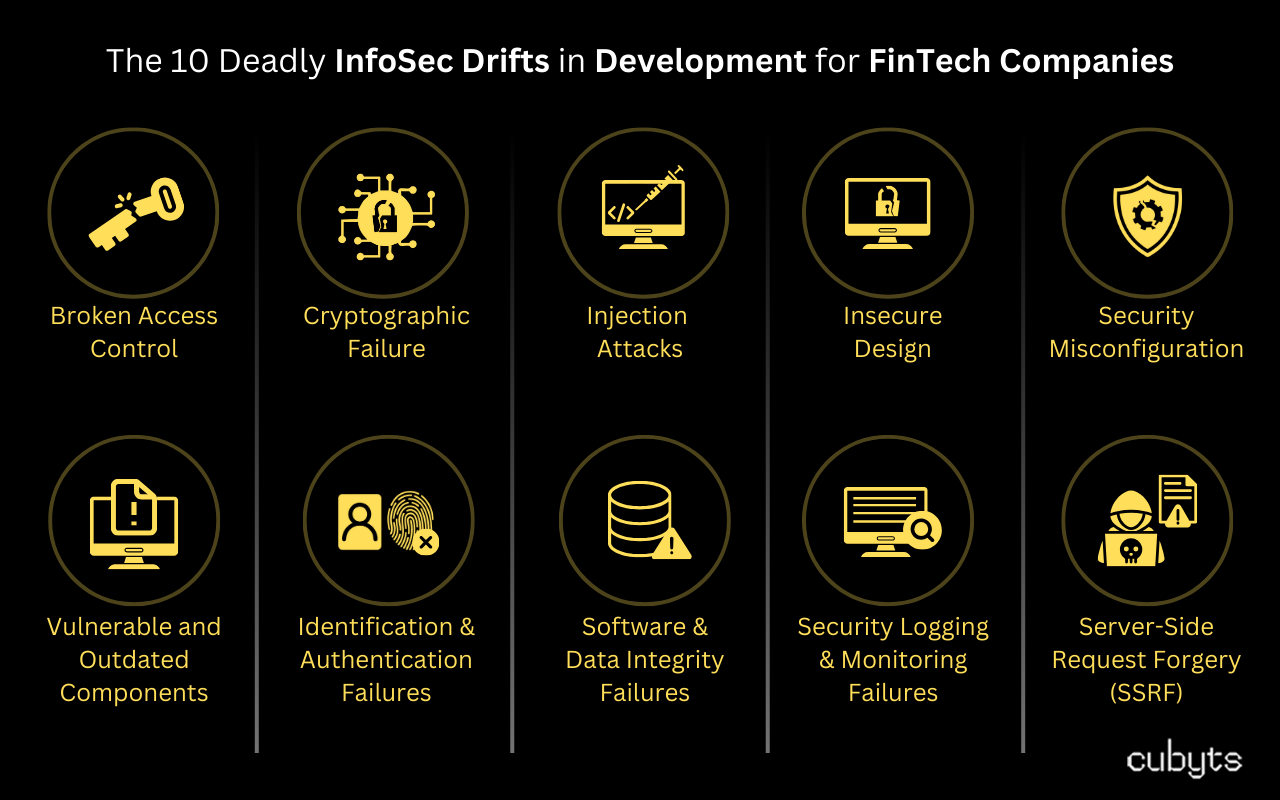The 10 Deadly InfoSec Drifts in Development for FinTech Companies
In FinTech, security is a critical priority. Handling sensitive financial data requires robust systems that proactively identify and resolve vulnerabilities. At Cubyts, InfoSec Drift refers to any deviation from expected security standards, best practices, or configurations. Addressing these drifts during development is essential for building secure, compliant, and reliable systems.

1. Broken Access Control
InfoSec Drift: Permissions or access controls are improperly configured, allowing unintended access to sensitive resources.
Impact: Unauthorized access can lead to financial fraud, data breaches, or regulatory violations.
Actions:
-
Implement role-based access controls (RBAC).
-
Enforce strict authorization checks on every API and endpoint.
-
Regularly review and correct access control configurations.
2. Cryptographic Failures
InfoSec Drift: Weak, outdated, or improperly implemented cryptographic practices are detected.
Impact: Sensitive data like customer credentials and transactions can be exposed during storage or transmission.
Actions:
-
Use strong encryption algorithms and deprecate weak ones.
-
Store passwords securely with salted hashing.
-
Ensure all data in transit uses TLS/HTTPS.
3. Injection Attacks
InfoSec Drift: Input validation is missing or improperly implemented, exposing the system to injection vulnerabilities.
Impact: Attackers can manipulate queries or commands to access or corrupt data.
Actions:
-
Use parameterized queries and prepared statements.
-
Validate and sanitize all inputs and outputs.
-
Address input validation gaps in the codebase.
4. Insecure Design
InfoSec Drift: Security weaknesses in the design stage lead to exploitable vulnerabilities.
Impact: Fundamental flaws in design can lead to privilege misuse, fraud, or abuse.
Actions:
-
Incorporate secure design principles in the development process.
-
Validate all user inputs and error handling mechanisms.
-
Apply rate-limiting and secure API workflows.
5. Security Misconfiguration
InfoSec Drift: Systems or components are configured with unnecessary or insecure settings.
Impact: Attackers can exploit misconfigurations to gain unauthorized access or expose sensitive data.
Actions:
-
Regularly audit and patch systems.
-
Disable unnecessary features or services.
-
Enforce secure default configurations and security headers.
6. Vulnerable and Outdated Components
InfoSec Drift: Outdated libraries or frameworks with known vulnerabilities are used in the application.
Impact: Using unmaintained or vulnerable components can expose critical parts of the system.
Actions:
-
Regularly update third-party libraries and dependencies.
-
Monitor dependency health and patch vulnerabilities.
-
Replace outdated components during scheduled maintenance.
7. Identification & Authentication Failures
InfoSec Drift: Authentication mechanisms fail to meet security requirements, exposing accounts to unauthorized access.
Impact: Attackers can impersonate users or access restricted systems.
Actions:
-
Enforce strong password policies and multi-factor authentication.
-
Implement account lockouts for repeated login attempts.
-
Ensure session management enforces expiration and invalidation.
8. Software & Data Integrity Failures
InfoSec Drift: Mechanisms to protect the integrity of software and data are missing or compromised.
Impact: Data manipulation or malicious content injection can compromise financial operations.
Actions:
-
Verify updates and imported functionality using cryptographic checks.
-
Avoid deserialization of untrusted data.
-
Secure cookies with validation and integrity checks.
9. Security Logging & Monitoring Failures
InfoSec Drift: Logs are incomplete or fail to capture critical security-relevant events.
Impact: Delayed detection of threats can lead to prolonged breaches and greater damage.
Actions:
-
Enable comprehensive logging for authentication attempts and privilege changes.
-
Protect logs from unauthorized access.
-
Use monitoring tools to detect anomalies in real-time.
10. Server-Side Request Forgery (SSRF)
InfoSec Drift: Unvalidated client-supplied inputs or misconfigured request handling allow server-side exploitation.
Impact: SSRF vulnerabilities can expose internal APIs or backend services to attackers.
Actions:
-
Validate and restrict URL inputs.
-
Monitor server-side request behaviors.
-
Avoid forwarding raw responses to users.
Why These InfoSec Drifts Are Deadly for FinTech Companies
For FinTech companies, InfoSec Drifts pose significant risks to customer data, operational integrity, and regulatory compliance. Even a single unresolved drift can result in data breaches, substantial fines, loss of customer trust, and serious disruptions to business operations. These drifts, if not managed effectively, threaten the very foundations of secure and reliable financial services.
Addressing these drifts during development is essential for ensuring robust security, seamless operations, and a strong reputation.
Cubyts, powered by AI, helps FinTech companies tackle these challenges by identifying and addressing drifts silently and efficiently. By integrating seamlessly into your workflow, Cubyts analyzes code and processes in real time, flags vulnerabilities, predicts potential issues, and provides actionable resolutions. This proactive approach allows FinTech teams to stay ahead of threats while maintaining focus on their core objectives and delivery timelines.